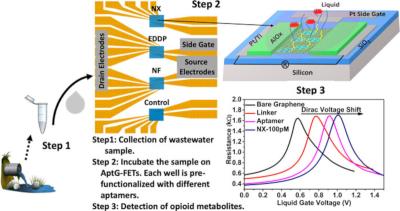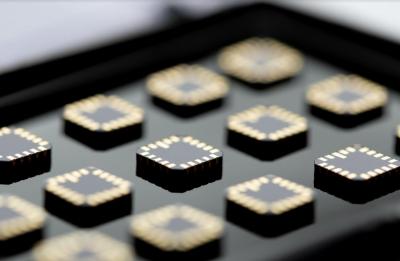Graphene sensors: introduction and market status - Page 11
Haydale secures Innovate UK grant to develop smart composite tooling
Haydale has announced that it has been awarded funding of £186,403 by Innovate UK, the UK's innovation agency, to develop smart composite tooling for the aerospace industry using functionalized nanomaterials.
The ESENSE project (Out-of-autoclave self-heated tooling enabling temperature homogeneity and embedded graphene sensors) aims to enhance out-of-autoclave (OOA) manufacturing processes with monitoring and through-life sensing capabilities using Haydale's patented HDPlas functionalization process to develop high temperature inks and pressure sensors. The project is due to start in April 2022 and is expected to run for 24 months.
Archer Materials reaches milestone in its disease-detecting graphene-based biochip
Archer Materials has announced a milestone in the development of its biochip, which is being created to detect various deadly communicable diseases.
The company achieved electronic transport in atom-thin graphene integrated with silicon electronics. Various voltage ranges were repeatedly recorded on the integrated devices when current-voltage traces were performed.
INBRAIN Neuroelectronics signs an agreement to develop neurotechnology patented by six public research institutions
INBRAIN Neuroelectronics has signed an agreement for the exploitation and development of three patents and a trade secret, mainly held by the Institute of Microelectronics of Barcelona (IMB-CNM) of the Spanish Council for Scientific Research (CSIC), the Catalan Institute of Nanoscience and Nanotechnology (ICN2), the Institució Catalana de Recerca i Estudis Avançats (ICREA) and the Biomedical Research Centre Network CIBER BBN. The Universitat Autónoma de Barcelona (UAB) and the Institut de Investigacions Biomèdiques August Pi i Sunyer (IDIBAPS) are also co-owners of the patents. This is a successful process of technology transfer in a public-private collaboration with multiple research institutions.
The company will carry out the development and manufacturing of these technologies within the Institut Català de Nanociència i Nanotecnologia (ICN2) and the Micro and Nanofabrication Clean Room of the Institute of Microelectronics of Barcelona (IMB-CNM) of the CSIC.
Avadain receives $3.77 million grant to upscale its graphene flakes tech to mass production
U.S-based graphene flakes producer Avadain has announced that it will upscale its environmentally friendly process to mass production as part of a two-year project funded by a $3.77 million grant from the U.S. Department of Commerce’s National Institute for Standards and Technology (NIST).
We are excited to unleash the Graphene Revolution by making large, thin and nearly defect free graphene flakes available in industrial volumes and acceptable cost, says Bradley Larschan, CEO of Avadain.
Graphenea launches Cartridge S2X for easy fabrication of graphene-based sensors
Graphenea has released a new product intended to make sensing with graphene easier: The Cartridge S2X, a package that interfaces the graphene microdevice and the electrical equipment used for its readout.

The cartridge has a small cleft onto which to place the GFET die, just below the electronics module with gentle pogo contacts to the graphene chip. The contacts are placed for seamless integration with Graphenea's S20, S21, S20P and S21P graphene chips that are especially designed for biosensing. The design makes use of 8 connections to the chip, including six source electrodes, one drain, and one gate. The pins are routed to a standard 8-pin BNC connector, for an easy and robust link to external measurement equipment.
Researchers design a graphene-based sensor that can detect opioids in wastewater
Researchers from Boston College, Boston University, and Giner Labs have designed a small graphene-based multiplexed bio-sensor that detects opioid byproducts in wastewater.

The novel device uses graphene-based field effect transistors to detect four different synthetic and natural opioids at once, while shielding them from wastewater’s harsh elements. When a specific opioid metabolite attaches to a molecular probe on the graphene, it changes the electrical charge on the graphene. These signals are easily read electronically for each probe attached to the device.
Researchers demonstrate control of the optical properties of graphene
An international team of scientists from the CNR-IFN, Politecnico di Milano, the University of Pisa, the Graphene Center of Cambridge (UK) and the Catalan Institute of Nanoscience and Nanotechnology (ICN2, Barcelona) has shown that the relaxation time of graphene charge carriers can be significantly modified by applying an external electrical field.
After light absorption, graphene's photoexcited charge carriers cool down to the initial equilibrium state in a few picoseconds, corresponding to a millionth of a millionth of a second. The remarkable speed of this relaxation process makes graphene particularly promising for a number of technological applications, including light detectors, sources and modulators.
Researchers develop new graphene-based sensor for rapid detection of bacterial pathogens
A research group from Sweden's Chalmers University of Technology and the Technical University of Denmark has shown that graphene can rapidly distinguish between types of bacteria. The team therefore set out to create extremely sensitive sensors, that can generate rapid signals upon bacterial colonization.â
The team developed a simple prototype sensor based on pristine, non-functionalized graphene. The detection principle is a change in electrical resistance of graphene upon exposure to bacterial cells. Without functionalization with specific receptors, such sensors cannot be expected to be selective to certain bacteria. However, the researchers demonstrated that two different bacterial species can be detected and differentiated by the new sensor due to their different growth dynamics, adherence pattern, density of adhered bacteria and microcolonies formation.
New chemical glucose sensing tech based on boronic acids and graphene foam
Researchers at the University of Bath, in collaboration with industrial partner Integrated Graphene, have developed a sensing technique based on graphene foam, for the detection of glucose levels in the blood.
The newly developed sensor is a chemical one instead of enzyme-based, which makes the technology robust, with a long shelf-life and more sensitive to lower glucose concentrations compared to current systems.
UK-based Paragraf raises $60 million in its latest financing round
UK-based graphene developer Paragraf has raised $60 million from the UK's Future Fund, the CIA-backed In-Q-Tel and other investors. The funds will be used to accelerate the company's device development, production and market launch.

Paragraf produces its own CVD graphene materials, which it then uses to create devices for the sensor, energy and semiconductor markets. The company introduced its first product, a graphene-based hall-effect sensor back in 2020, and it has recently concluded a study to test the deployment of graphene as an OLED electrode material.
Pagination
- Previous page
- Page 11
- Next page